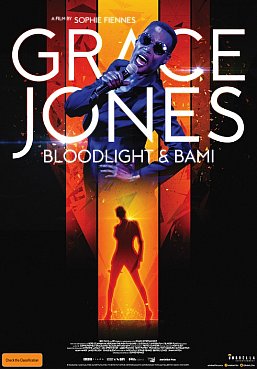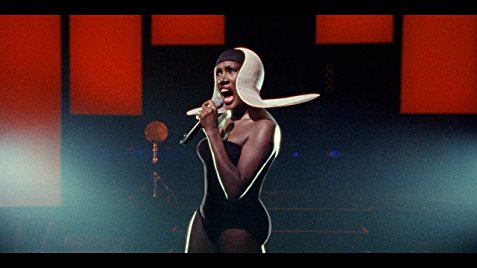by Melanie Crew
Managing Editor
GRACE JONES: BLOODLIGHT AND BAMI (2017); Dir. Sophie Fiennes; Starring Grace Jones, Jean-Paul Goude, Sly & Robbie; Opens Friday, April 27 at the Landmark Midtown Art Cinema; Trailer here.
Grace Jones has affectionately been dubbed an “iconic extraterrestrial” raising the bar of hardcore, rebellious femininity. Sophie Fiennes’ [THE PERVERT’S GUIDE TO IDEOLOGY (2012)/dir.; THE PERVERTS GUIDE TO CINEMA (2006)/dir.] portrayal of the larger-than life pop icon transports Jones back to earth, exposing the soft underbelly Jones’ audiences rarely get a chance to experience. Nearly five years in the making, Fiennes followed Jones during the recording of her 2008 album, HURRICANE and through her 2009 World Tour, giving audiences a small glimpse into the life of the legendary Ms. Jones in the first feature-length documentary dedicated solely to the pop music icon, also known for her roles in CYBER BANDITS (1995); A VIEW TO A KILL (1985); CONAN THE DESTROYER (1984) and more.
Throughout the film, Fiennes dynamically paints Jones’ story using bright reds, blues and greens, explaining that “Bloodlight” in Jones’ regional Jamaican dialect refers to the red light that illuminates when an artist is recording. The film opens on Jones belting out “Slave to the Rhythm” during her 2009 World Tour and then we’re transported back in time to Jamaica where she’s preparing to record HURRICANE. It’s during this trip that she reunites with family and friends and we are slowly acquainted with Jones’ childhood demons  which helped create the androgynous, gender-defying powerful presence we all know and adore, Grace Jones.
which helped create the androgynous, gender-defying powerful presence we all know and adore, Grace Jones.
On stage, Jones is a GOD. She is a GODDESS. In fact, she’s both—a chameleon channeling the extremes of societal roles. Throughout the film we are given the chance to experience Jones’ dynamic live stage show with performances of her new wave/post-punk tune, “Pull Up to the Bumper,” originally released on her 1981 NIGHTCLUBBING album, and “Williams’ Blood,” released in 2008 as part of HURRICANE. In the short span of 115 minutes, Fiennes gently exposes Jones’ traumatic history while giving Jones the ability to enlighten her fans on how she became the icon we’ve all grown to admire. Jones delves deep into her past, exposing the trauma she faced as a child perpetuated by her stepfather, Master Patrick (Mas. P). Jones details her transformation from real-life woman to domineering stage presence, stating, “I’m playing out Mas P. That’s why I’m scary. That’s the male dominant scary person I become.”
Jones was born in Jamaica and was transplanted to Syracuse, New York as a young teen. She rose to stardom having the gift to mesmerize crowds and soon became a muse to many artists and photographers, including photographer Jean-Paul Gaude, father of Jones’ son, Paulo Gaude. She wears many masks (literally and figuratively) in the entertainment industry, from singer/songwriter to record producer to supermodel to movie star. Fiennes touches on many of these aspects of Jones’ life throughout the film. We get a chance to unmask the  artist as we delve further into her more domesticated roles as mother, grandmother, sister, lover, and friend, or what in Jones’ regional dialect is dubbed, “bami,” bread, the substance of daily life.
artist as we delve further into her more domesticated roles as mother, grandmother, sister, lover, and friend, or what in Jones’ regional dialect is dubbed, “bami,” bread, the substance of daily life.
Fiennes hand-delivers an intimate portrait of a behind-the-scenes “real life” Jones, blended with her gargantuan, overtly experimental avant-garde, cutting-edge stage presence. Fittingly, Fiennes utilizes sharp cuts and fades as she ever so slowly reveals the tale of Jones’ childhood through the memories provided by Jones’ family and friends. GRACE JONES: BLOODLIGHT AND BAMI is a film well worth experiencing, especially for those who have a deep love for pop culture. If you are hungry for brutally amazing strong female leads, Fiennes’ documentary is exactly what you need. Peter Bradshaw of The Guardian brilliantly says of Fiennes’ film, “It’s a reminder that films about female singing stars need not be gallant tributes to tragically doomed fragility.”
Grace Jones is anything but fragile, and if there ever was a glass ceiling holding her back, you can rest assured that she smashed it to unrecognizable bits with poise and grace, as she so delicately puts it, “Sometimes you have to be a high flying bitch.”




